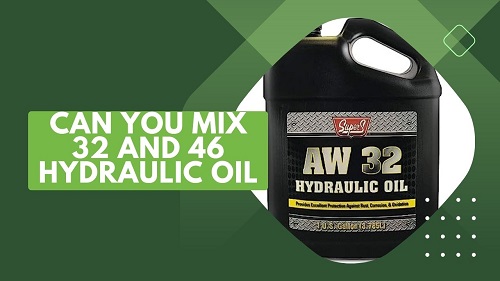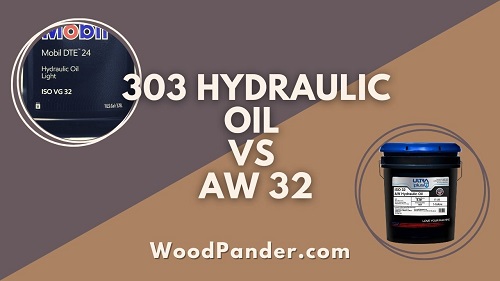Can You Mix 46 And 68 Hydraulic Oil?
Hydraulic oil plays a crucial role in hydraulic systems by providing lubrication, heat transfer, and energy transmission.
Different grades of hydraulic oil are available, designated by their viscosity, which is a measure of the oil’s resistance to flow.
The viscosity grade is typically indicated by a number, such as 46 or 68, which corresponds to the oil’s thickness.
Mixing 46 and 68 hydraulic oil is generally not recommended due to compatibility issues and potential risks to system performance and equipment.
Can You Mix 46 And 68 Hydraulic Oil
| Aspect | Mixing 46 Hydraulic Oil | Mixing 68 Hydraulic Oil |
|---|---|---|
| Viscosity | Moderately Thin | Moderately Thick |
| Lubrication Performance | Slightly Compromised | Slightly Compromised |
| Friction and Wear | Increased | Increased |
| Heat Transfer | Potentially Inadequate | Potentially Inadequate |
| System Efficiency | Decreased | Decreased |
| Risk of Equipment Damage | Moderate | Moderate |
| Compatibility | Potentially Incompatible | Potentially Incompatible |
| Recommended Practice | Avoid Mixing | Avoid Mixing |
One of our articles –Can You Mix ATF and Hydraulic Fluid?
Understanding Hydraulic Oil Grades

What is Hydraulic Oil?
Hydraulic oil is a specially formulated fluid designed to meet the unique demands of hydraulic systems.
It typically consists of a base oil and additives that enhance its performance characteristics, such as anti-wear properties, oxidation resistance, and foam suppression.
Hydraulic Oil Viscosity Grades
| Viscosity Grade | Description | Common Applications |
|---|---|---|
| ISO 15 | Very Thin | Precision instruments, light-duty hydraulic systems |
| ISO 22 | Thin | Low-pressure hydraulic systems, small hydraulic components |
| ISO 32 | Moderate | General-purpose hydraulic systems, mobile equipment |
| ISO 46 | Medium | Industrial hydraulic systems, heavy-duty equipment |
| ISO 68 | Thick | High-pressure hydraulic systems, large machinery |
| ISO 100 | Very Thick | Hydraulic systems with wide temperature variations |
| ISO 150 | Extremely Thick | Hydraulic systems operating under extreme conditions |
One of our articles –Can You Mix Different Grades Of Hydraulic Oil?
Hydraulic oil viscosity grades are classified based on the oil’s resistance to flow at different temperatures.
The most common viscosity grades are represented by numbers, such as ISO 32, 46, 68, and 100. The higher the number, the thicker the oil and vice versa. The viscosity grade selection depends on factors like system design, ambient temperature, and operating conditions.
Importance of Correct Hydraulic Oil Grade
| Aspect | Importance |
|---|---|
| Optimal System Performance | Correct hydraulic oil grade ensures optimal system performance by providing proper lubrication, heat transfer, and energy transmission. |
| Longevity of Components | Using the correct grade helps extend the lifespan of hydraulic system components, such as pumps, valves, and seals, by minimizing wear and tear. |
| Efficient Energy Transmission | The right viscosity grade allows for efficient energy transmission, resulting in improved system efficiency, reduced energy consumption, and increased productivity. |
| Temperature Stability | Correct oil grade selection ensures temperature stability, preventing overheating or viscosity breakdown that could negatively impact system operation. |
| Protection against Wear | The right viscosity grade provides adequate film thickness, protecting components from friction, wear, and potential damage. |
| Compatibility with Seals | Using the appropriate oil grade helps maintain compatibility with seals, gaskets, and other materials, preventing leaks and system malfunctions. |
| Manufacturer Recommendations | Following equipment manufacturer recommendations ensures warranty compliance and reliable operation of the hydraulic system. |
| Avoidance of Downtime | Using the correct hydraulic oil grade reduces the risk of unexpected failures, minimizing costly downtime and maintenance. |
One of our articles –Can You Mix Different Brands Of Hydraulic Fluid?
Using the correct hydraulic oil grade is essential to ensure optimal system performance and longevity. The viscosity of the oil affects the system’s ability to lubricate, transmit power, and dissipate heat.
Choosing an improper oil grade can result in inadequate lubrication, increased wear, reduced efficiency, and potential equipment damage.
Mixing Hydraulic Oil Grades
| Aspect | Mixing Hydraulic Oil Grades |
|---|---|
| Compatibility | Potential compatibility issues |
| Viscosity | Inconsistent viscosity throughout the system |
| Lubrication | Reduced lubrication performance |
| Wear and Tear | Increased friction and wear |
| Heat Transfer | Potentially compromised heat transfer |
| System Efficiency | Decreased efficiency |
| Equipment Damage | Potential damage to equipment |
| Best Practice | Avoid mixing if possible |
Compatibility Issues
While it is technically possible to mix different grades of hydraulic oil, it is generally not recommended. Hydraulic oils with different viscosity grades have distinct formulations, and mixing them can lead to compatibility issues.
These compatibility issues may cause changes in the oil’s properties, such as reduced lubricity and increased foaming.
Effects of Mixing 46 and 68 Hydraulic Oil
Mixing 46 and 68 hydraulic oil grades can have several adverse effects on the hydraulic system. Firstly, it can lead to an inconsistent viscosity throughout the system, affecting the lubrication of components and resulting in increased friction and wear.
Additionally, the mixed oil may have compromised heat transfer capabilities, potentially leading to overheating of the system.
Factors to Consider
Equipment Manufacturer Recommendations
It is crucial to follow the equipment manufacturer’s recommendations regarding hydraulic oil grades.
They have extensive knowledge of the system’s design, tolerances, and operating conditions. Deviating from their recommendations may void warranties and compromise the system’s performance.
Operating Conditions
Consider the operating conditions of the hydraulic system when selecting hydraulic oil grades. Factors such as temperature extremes, load requirements, and duty cycles can impact the oil’s viscosity requirements.
Consulting with experts or referring to industry standards can help in making informed decisions.
Oil Contamination
Contamination is a significant concern in hydraulic systems and can affect oil performance. Mixing different oil grades increases the risk of contamination, as additives and properties may not be compatible.
Contaminated oil can lead to system malfunctions and component failures.
Maintenance Practices
Proper maintenance practices, such as regular oil sampling and analysis, play a crucial role in ensuring hydraulic system performance. Regular monitoring helps identify any oil degradation or contamination, allowing for timely corrective actions to be taken.
Risks and Consequences of Mixing Hydraulic Oil Grades
Reduced Lubrication Performance
Mixing different hydraulic oil grades can result in reduced lubrication performance. The inconsistent viscosity can compromise the oil’s ability to create a protective film on moving parts, leading to increased friction and wear.
Increased Wear and Tear
Inadequate lubrication due to mixed oil grades can accelerate wear and tear of hydraulic system components. Increased friction can cause premature failure of seals, pumps, valves, and other critical parts, leading to costly repairs and downtime.
Decreased System Efficiency
Hydraulic systems rely on efficient energy transmission for optimal performance. Mixing hydraulic oil grades can hinder this energy transmission, resulting in reduced system efficiency. Decreased efficiency leads to higher energy consumption and lower productivity.
Potential Damage to Equipment
One of the most significant risks of mixing hydraulic oil grades is the potential damage it can cause to equipment. Incompatible oil formulations may react with seals, gaskets, and other materials, leading to degradation, leaks, and system malfunctions.
The cost of repairing or replacing damaged equipment can be substantial.
Best Practices for Hydraulic Oil Mixing
| Best Practice | Description |
|---|---|
| Flushing and Replacing Oil | Completely flush the system and replace all the oil to minimize compatibility issues. |
| Consulting Equipment Manufacturer | Seek guidance from the equipment manufacturer or hydraulic system expert for proper recommendations. |
| Regular Oil Sampling and Analysis | Implement a regular oil sampling and analysis program to monitor the health of the hydraulic system. |
| Compatibility Testing | Perform compatibility testing when mixing hydraulic oils to assess potential issues. |
| Maintaining Proper Documentation | Keep accurate records of oil changes, mixing procedures, and any maintenance performed. |
| Proper Oil Storage and Handling Practices | Adhere to proper oil storage and handling practices to prevent contamination and degradation. |
| Training and Education | Provide training and education to personnel on proper oil mixing procedures and best practices. |
Flushing and Replacing Oil
If mixing hydraulic oil grades becomes necessary due to unforeseen circumstances, it is essential to follow proper procedures. Flushing the system and replacing the oil entirely can help minimize compatibility issues and ensure the new oil is consistent throughout the system.
Consulting Equipment Manufacturer
Before considering mixing hydraulic oil grades, consult with the equipment manufacturer or a hydraulic system expert. They can provide valuable insights into the system’s requirements and guide you on the best course of action.
Regular Oil Sampling and Analysis
Implementing a regular oil sampling and analysis program is vital for monitoring the health of the hydraulic system. By regularly assessing the oil’s condition, potential issues can be detected early, allowing for preventive maintenance and avoiding costly problems.
Related Questions
Can I mix hydraulic oils with different viscosity grades if I run out of a specific grade?
Mixing hydraulic oils with different viscosity grades is generally not recommended, even if you run out of a specific grade.
It is best to follow the manufacturer’s recommendations and use the recommended oil grade for optimal performance.
Will mixing 46 and 68 hydraulic oil damage my equipment immediately?
Mixing 46 and 68 hydraulic oil can potentially damage equipment over time. It may lead to reduced lubrication, increased wear, decreased efficiency, and possible equipment failure.
The extent of damage depends on various factors, including the duration of oil mixing and the specific hydraulic system.
Can I mix hydraulic oils from different brands?
Mixing hydraulic oils from different brands can be risky due to potential incompatibilities between additives and formulations.
It is generally advisable to use oils recommended by the equipment manufacturer or consult with experts before considering such mixtures.
How can I prevent the need for mixing hydraulic oil grades?
To avoid the need for mixing hydraulic oil grades, it is essential to maintain proper inventory management. Regularly monitor oil levels, perform routine maintenance, and follow recommended oil change intervals to ensure an adequate supply of the required hydraulic oil grade.
Are there any additives that can be used to improve compatibility when mixing hydraulic oil grades?
While there are additives available in the market, it is generally not recommended to use additives to improve compatibility when mixing hydraulic oil grades.
The best approach is to follow manufacturer recommendations and avoid mixing different grades whenever possible.
Conclusion
Mixing hydraulic oil grades, such as 46 and 68, can have significant implications for the performance and longevity of hydraulic systems.
While it may be technically feasible, it is generally not recommended due to compatibility issues and the associated risks.
To ensure optimal system performance, it is crucial to select the correct hydraulic oil grade according to the equipment manufacturer’s recommendations, operating conditions, and maintenance practices.
Resources:
https://www.sae.org/gsdownload/?prodCd=2000-01-2033
https://www.tandfonline.com/doi/abs/10.1080/10402004.2022.2163947








